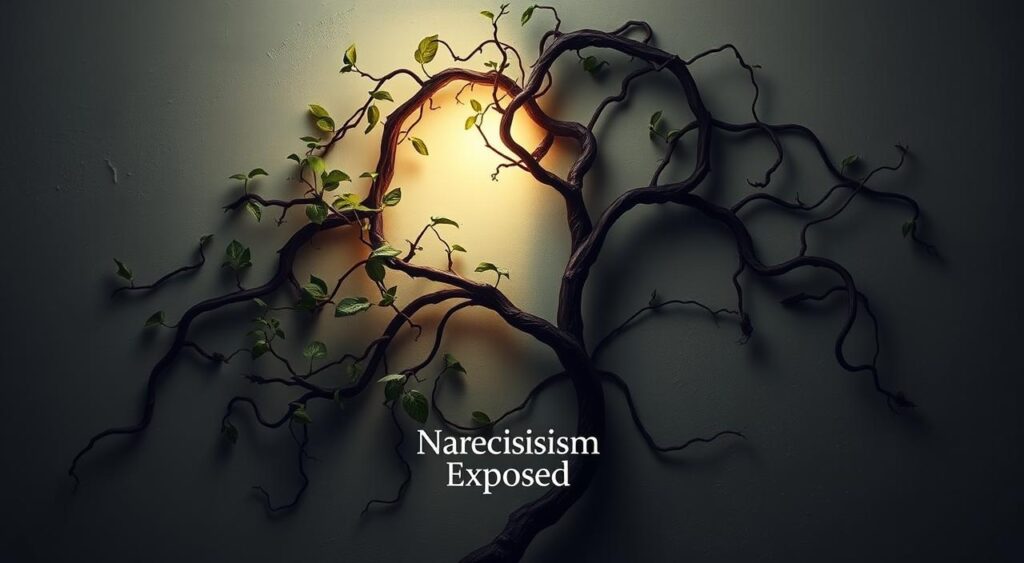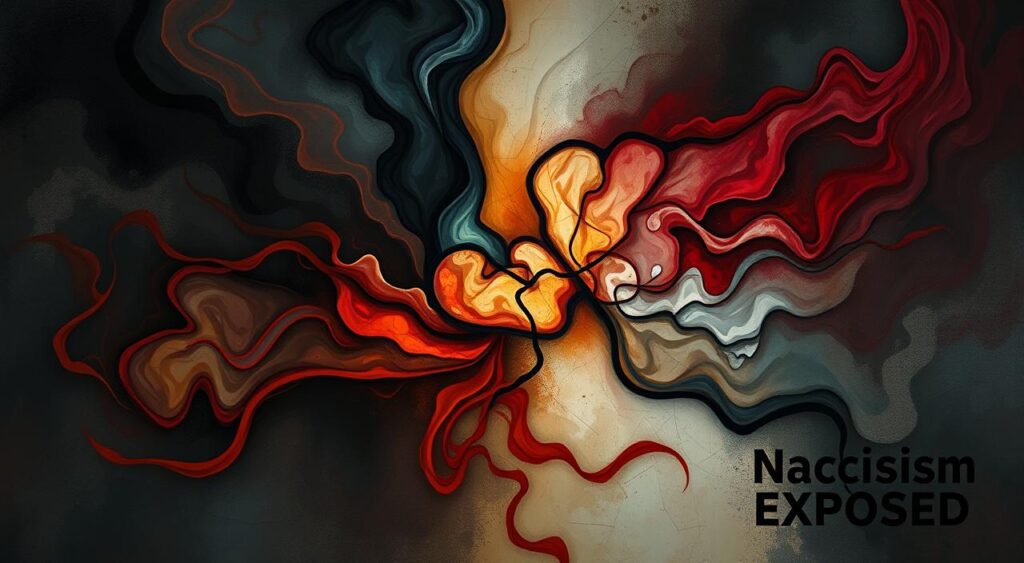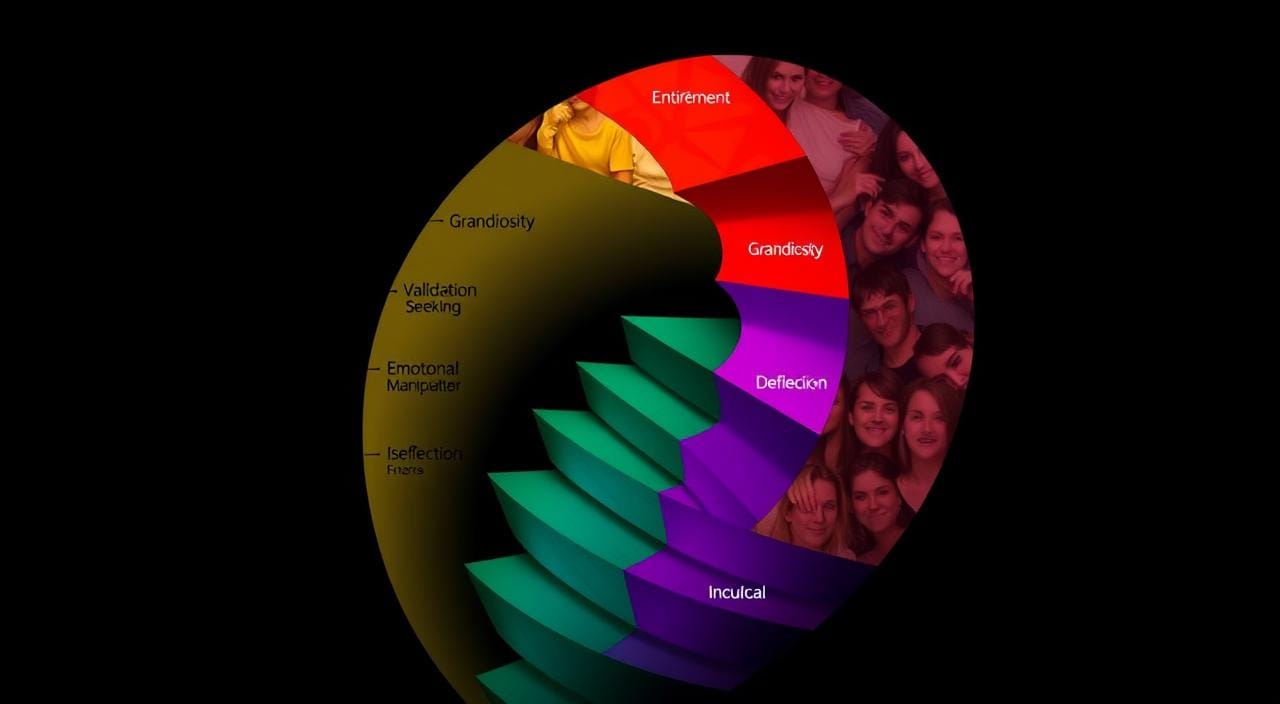Reflecting on my journey with a covert narcissist, I feel deep empathy for others in similar situations. Covert narcissists are experts at making their partners feel trapped in a cycle of control. They use their need for admiration and lack of empathy to manipulate others1. Let’s discuss how a covert narcissist creates codependency in relationships?
Codependent people often put others first, making them easy targets for narcissists. Their needs match perfectly, creating a cycle of giving and taking that’s hard to break1. This cycle keeps the relationship toxic and emotionally charged1.
Key Takeaways
- Covert narcissists are highly manipulative, creating a toxic dynamic of codependency in relationships.
- Codependents are vulnerable to the narcissist’s exploitative tactics due to their tendency to prioritize others’ needs.
- The complementary needs of codependents and narcissists form a destructive relationship dynamic.
- Covert narcissists employ subtle, invisible manipulation tactics to maintain control and exploit their partners.
- Recognizing the warning signs of covert narcissistic behavior is crucial for breaking free from the cycle of abuse.
The Complementary Needs of Codependents and Narcissists
Codependency and narcissism often go hand in hand in unhealthy relationships. Codependents deeply want to help and support others, often ignoring their own needs. They look for approval and validation from their partners, making them easy targets for narcissists.2 Narcissists, however, crave admiration and control. They use the codependent’s need for love and approval to their advantage.
This cycle makes the codependent more and more dependent on the narcissist, who keeps taking advantage of their need for love.2 Codependents often feel bad about themselves and look to their partners for validation, which feeds the narcissist’s ego.2 At first, narcissists make their codependent partners feel special, giving them lots of attention.2
Codependency: The Need to Nurture and Enable
Codependency means relying too much on others for approval and wanting to please them too much. This can harm one’s own needs and personal space.2 Codependents have trouble setting boundaries, making them easy targets for narcissists who use emotional abuse.2
Narcissism: The Craving for Admiration and Control
Narcissists often pick codependent partners because they meet their emotional needs and desires.2 They switch from idealizing to devaluing their partners, causing emotional pain and confusion.2 This relationship can lead to burnout for the codependent, who always gives and sacrifices, feeling emotionally drained.2
“The allure of narcissists for codependents lies in the validation and approval the narcissistic partners provide to boost self-esteem.”2
Self-verification theory says codependents may look for proof that their negative views of themselves are right, which narcissists can provide.2
The Covert Narcissist’s Manipulation Tactics
Covert narcissists are experts at keeping control in their relationships3. They pretend to be humble, vulnerable, and introverted. This hides their true self-centeredness and need for constant attention and pity3. These tricks confuse and make their partners doubt themselves, making it hard to see the abuse and set limits.
Gaslighting and Emotional Abuse
Gaslighting is a key trick used by covert narcissists. They make their partners doubt their own reality and thoughts4. This can deeply affect someone’s independence and self-esteem4. They also use emotional abuse to lower their partner’s self-worth and confidence.
Guilt-Tripping and Playing the Victim
Covert narcissists often use guilt-tripping and acting like victims5. They make their partners feel guilty, anxious, and ignore their own needs5. This creates a cycle where the partner feels they must make the narcissist happy4.
These narcissists control their partners by using power and control. They make their partners feel powerless and without control5. They bully in ways that go unnoticed by others, forcing their partners to do what they want5.
It’s important to know how covert narcissists manipulate to escape these relationships. Learning the signs of narcissistic abuse, staying aware without getting caught up, and getting help can help you regain your self-worth and confidence5.
How a Covert Narcissist Creates Codependency in Relationships
Covert narcissists are experts at making their partners feel trapped in a codependent relationship. They start by giving lots of love and attention, then suddenly stop. This makes their partners feel they need their approval badly6. This creates a strong emotional tie, known as a trauma bond, making the partner deeply involved despite the abuse6.
They also play on their partner’s fears of being left alone. This makes the partner feel they can’t live without the narcissist’s love and support6. Over time, the partner becomes too dependent on the narcissist, making it hard to leave6.
Covert narcissists use guilt trips to control their partners. This stops the partner from standing up for themselves or being independent6. The partner ends up feeling anxious and puts the narcissist’s needs first, ignoring their own6.
These narcissists are tricky because they’re not openly mean. They use invisible bullying to make their partners do what they want through emotional tricks6.
They target people who don’t have strong self-esteem or clear boundaries. Getting support from friends and seeing a therapist is key to escaping a toxic relationship with a covert narcissist6.
“The ‘Observe Don’t Absorb’ technique helps detach from the emotional manipulation of covert narcissists, maintaining control and setting healthy boundaries.”
Psychoanalyst James Masterson found a type of narcissist who is hard to spot because they seem shy or humble7. These covert narcissists are subtle in their abuse, making it hard to see7.
They might act passive-aggressive, like saying yes but not doing it, or showing hidden smugness7. Their silent abuse slowly wears down their partners, making them feel bad about themselves7.
Being with a covert narcissist can make someone feel their worth is less and their needs ignored7. These narcissists don’t care about others’ feelings, leaving their partners feeling alone7.
Narcissistic personality disorder is a mental issue marked by thinking too highly of oneself and not caring about others8. Studies show it’s linked to cheating, violence at home, and sex addiction8.
To change, a narcissist must realize and want to change themselves8. Being aware and speaking up is key to building healthy relationships with narcissists8.
Seeing a therapist is a good idea if you feel controlled or abused by a covert narcissist7. It’s important to stop the cycle of being controlled and focus on loving and caring for yourself. Learn more about managing guilt and overcoming narcissistic abuse678
The Cycle of Control and Caretaking
In narcissist-codependent relationships, a cycle of control and caretaking often starts9. The codependent person becomes the caretaker, always trying to meet the narcissist’s huge needs910. This comes from deep feelings of need, deprivation, and a wish to get approval and validation10.
The Codependent’s Role as Caretaker
The codependent takes on blame, guilt, and shame, hurting their self-esteem over time9. They hold on to the relationship, risking their own happiness to control the narcissist and get their love10. This codependent caretaking can lead to poor boundaries, enabling the narcissist, and ignoring the caretaker’s own needs10.
The Narcissist’s Exploitation of the Caretaker
The narcissist uses the codependent’s need to be needed, making them give more without getting much back9. This narcissistic exploitation makes the narcissist feel superior and entitled, while the codependent’s self-worth depends on pleasing the narcissist911. Over time, this power dynamic in abusive relationships gets harder to escape, as both partners get deeper into their roles9.
To break free from this emotional dependency, the codependent must focus on their recovery and self-care, set boundaries, and get professional help911. Then, they can start to heal and find healthier, more balanced relationships11.
Emotional Intensity and Confusion
The emotional intensity in a codependent-narcissist relationship can be very misleading. Codependents often accept the abusive behavior of narcissists, fearing being alone. They are too scared to leave and face solitude1>. This shows how often they tolerate bad behavior1>.
Narcissists can switch between idealization and devaluation. They may be very loving and kind one moment, then harsh and critical the next. This makes the codependent feel lost, always trying to please the narcissist. They can’t see the true manipulative and emotional abuse in the relationship.
In these relationships, partners often switch roles between being anxious and avoidant. The narcissist usually uses hard power, while the codependent uses soft power1>. This creates a confusing and unhealthy emotional space. It leaves the codependent in a state of constant idealization and devaluation.
To escape from this emotional abuse and trauma bonding, the codependent must face themselves and the relationship’s patterns. Codependents often lack a strong ego and connection to their true self1>. They rely too much on others for validation and struggle with finding their own identity1>. It’s important to recognize and work on these issues to regain emotional balance and end the cycle of codependency and narcissism.
“The emotional rollercoaster can leave the codependent feeling confused, constantly seeking the narcissist’s approval and validation, and unable to recognize the underlying manipulative and emotional abuse inherent in the relationship.”
Recognizing the Warning Signs
Dealing with covert narcissists in relationships can be tough. It’s key to spot the early signs to dodge narcissistic abuse12. These folks often don’t care much about others’ feelings or needs12. They always want lots of attention and praise from their partners12. These signs are like red flags, showing the relationship might be bad and even abusive.
Lack of Empathy and Emotional Unavailability
Covert narcissists often lack empathy and don’t show much emotion12. They might seem nice and caring at first, but soon, they ignore their partner’s feelings and needs12. These people find it hard to connect on an emotional level. They can seem distant, making their partners feel ignored and not supported.
Constant Need for Validation and Attention
Covert narcissists always need lots of praise and attention from their partners12. If they don’t get what they want, they might get angry or act out. They use tricks to keep control. This can make the partner feel like they’re always trying not to upset the narcissist.
Seeing these signs early can help you deal with the issues and maybe get out of a bad situation1213. Knowing about covert narcissism and codependency helps you protect your feelings. It’s a step towards finding healthier relationships.
“Narcissists are selfish, self-consumed, demanding, entitled, and controlling individuals, while codependents are giving, sacrificing, and consumed with the needs and desires of others.”
Strategies for Breaking Free
Getting out of a relationship with a covert narcissist is tough, but it can be done with the right help and steps. Covert narcissists are experts at controlling others, making it hard to leave14. Yet, by setting boundaries, getting professional advice, and making a safety plan, you can start to take back your life and your self-respect.
Establishing Boundaries and a Support System
First, you need to set clear boundaries to break free from a covert narcissist. This means limiting how much you talk, setting rules for communication, and not letting them play on your feelings15. It’s also key to build a circle of friends, family, or professionals who can support you15. They can offer the support and positive feedback you need to move forward.
Seeking Professional Help and Creating a Safety Plan
Talking to a therapist or counselor is a big help in overcoming codependency and leaving a narcissistic relationship15. They can help you understand the abuse, teach you how to cope, and make a safety plan15. This plan might include finding a safe place to stay, getting financial help, and preparing for the challenges of leaving the narcissist.
By being proactive, you can set boundaries, get professional advice, and make a safety plan to escape a covert narcissist’s control. This starts your journey to recovery from codependency1415.
“The first step towards breaking free from a covert narcissist is to recognize the pattern of abuse and take the necessary actions to protect yourself. It’s a challenging journey, but with the right support and strategies, it is possible to reclaim your life and your sense of self-worth.”
Conclusion
Breaking free from toxic relationships with covert narcissists is possible16. Understanding the needs and behaviors of both codependents and narcissists helps. This knowledge lets people spot the signs early and start healing.
Covert narcissists use tricks like gaslighting to control their partners16. Yet, setting boundaries and getting help can help victims. They can start to rebuild their self-esteem and escape the cycle of codependency and toxic relationships.
Recovery is hard but doable with the right support17. Focusing on self-care and building a supportive circle is key. With time and effort, people can move past the harm of emotional abuse and covert narcissism. They can then find healthier, more positive relationships in the future.
FAQ
What is the relationship dynamic between a covert narcissist and a codependent partner?
Covert narcissists and codependent partners often form a toxic bond. The narcissist craves admiration and control. The codependent seeks to please and validate the narcissist. This cycle of control and caretaking is harmful.
What manipulation tactics do covert narcissists use to create codependency in relationships?
Covert narcissists use tactics like gaslighting and emotional abuse to control. They also guilt-trip and play the victim. These actions confuse and doubt the codependent, making it hard for them to see the abuse.
How do covert narcissists use love bombing and trauma bonding to create codependency?
At first, covert narcissists shower their partners with love and attention. Later, they pull back, leaving the partner wanting their approval. This can create a strong emotional bond, despite the abuse.
What is the cycle of control and caretaking in a codependent-narcissist relationship?
In these relationships, the codependent takes on a caretaker role. They try to meet the narcissist’s needs. The narcissist uses this need to manipulate, getting more from the codependent while giving little back.
How can the emotional intensity of a codependent-narcissist relationship be misleading?
The emotional depth of these relationships can be deceiving. The codependent may see the narcissist’s attention as real love. The narcissist’s behavior can switch between idealization and devaluation, making it hard to see the true nature of the relationship.
What are some warning signs of a covert narcissist in a relationship?
Look out for a lack of empathy and emotional distance. They also need constant validation. These signs suggest the relationship might be unhealthy and abusive.
How can someone break free from a relationship with a covert narcissist?
Getting out of such a relationship is tough but doable. Start by setting clear boundaries and building a support network. Consider professional help and make a safety plan. These steps can help you recover and heal.
Source Links
- The Overlap Between Codependency and Narcissism in Relationships – Start My Wellness, Ferndale, MI – https://startmywellness.com/2024/03/codependency-and-narcissism-in-relationships/
- Narcissist And Codependent Compatibility In Relationships – https://www.simplypsychology.org/the-dance-between-codependents-narcissists.html
- Covert Narcissism: Don’t Be Manipulated — Meadow DeVor – https://www.meadowdevor.com/md-podcast/2023/8/28/covert-narcissism-are-you-being-manipulated-and-dont-even-know-it
- covert narcissist creates codependency in relationships – Chicaural – https://chicaural.com/covert-narcissist-creates-codependency-in-relationships/
- How to Break Free from a Covert Narcissist – https://www.selfloverecovery.com/blogs/blog/guilt-management?srsltid=AfmBOorMaETDmMWDEjWxsNIZSDmYOOCBIljNuDKHjKaEUCzHraew3pm5
- How to Break Free from a Covert Narcissist – https://www.selfloverecovery.com/blogs/blog/guilt-management?srsltid=AfmBOornn1DbrPX4aHsA2ZFmEg_M2VroBUkFTCiGAzNfK-znVVYbXiEs
- The Danger of a Covert Narcissist | What Is Codependency? – https://whatiscodependency.com/what-is-covert-narcissist/
- How Narcissists Form Abusive, Co-Dependent Relationships – https://www.psychologytoday.com/intl/blog/communication-success/201804/how-narcissists-form-abusive-co-dependent-relationships
- Changing Codependent Dynamics in Abusive Relationships – https://whatiscodependency.com/codependents-abusive-relationships-narcissist-borderline/
- Are You a Caregiver or Codependent Caretaker? by Darlene Lancer, MFT – https://whatiscodependency.com/caregiver-vs-caretaker-codependency/
- The Dynamics of Codependency – https://medium.com/@unitythroughtrauma/the-dynamics-of-codependency-104881c0cb78
- The subtle signs of Covert Narcissism – what to look out for – https://www.drsarahdavies.com/post/covert-narcissism-what-to-look-out-for
- The Human Magnet Syndrome: The Codependent Narcissist Trap – Everyday Adventures – https://www.everydayadventures.com/the-human-magnet-syndrome-the-codependent-narcissist-trap/
- How to Break Free from a Covert Narcissist – https://www.selfloverecovery.com/blogs/blog/guilt-management?srsltid=AfmBOoqFRxdpDRjWzczY7z5N7dSCaYTVq4QBvwPs_JnGjhi0s3U9OQ5W
- Breaking The Bond Between Narcissist And Codependent – https://theonlinetherapist.blog/breaking-the-bond-between-narcissist-and-codependent/
- Narcissists are Codependents, Too | What Is Codependency? – https://whatiscodependency.com/narcissists-are-codependents-too/
- Understanding Narcissistic Parenting Effects – https://thebetteryouinstitute.com/2022/05/16/children-of-a-narcissist/












